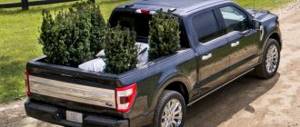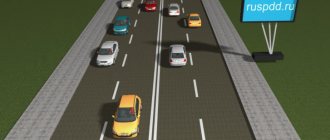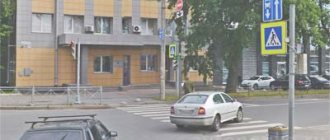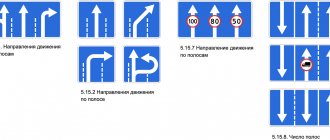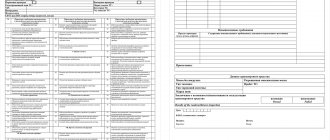The number of vehicles owned by Russians increases by several thousand every year. Therefore, it is not surprising that we spend a decent amount of time in traffic jams every day. Most often, congestion on the roadway occurs in the same place and at certain hours. In this regard, reversible lanes are organized on roads in such areas.
The word reverse itself means return. In road traffic - the ability to move a vehicle in one lane in two directions.
That is, first the flow moves in one direction, and then in the opposite direction. The lane on which the movement takes place remains the same.
Reversible traffic light, what is it?
Every driver has heard about the term “reverse movement”. However, not everyone has encountered it in reality. Reversing movement is often used at a certain period of time when it is required.
The need for these lanes arises on those sections of roads where traffic intensity changes throughout the day. So, for example, in the morning everyone rushes from home to work, and in the evening, vice versa. And in order to avoid hours-long traffic jams, special lanes are being introduced.
Traffic regulation is carried out by means of a traffic light, a traffic police officer or road workers. A reversible traffic light controls traffic in the lane above which it is located.
Sometimes these traffic lights are used in tunnels. Installed above the rows, they make it possible to regulate traffic on the lanes in a short period of time during road accidents or during repair work on the roadway.
Signs of a reversible lane
Any driver does not want to become the culprit of a traffic accident. Therefore, every car owner is obliged to remember the traffic rules and repeat them from time to time, since changes are made to the rules every year.
So, the main signs of reverse movement that the driver must pay attention to:
- Working reversible traffic light.
- Sign indicating the beginning of a reversible lane.
- Marking in the form of a double broken line on both sides of the strip.
Marking during reverse movement
Reversible lanes are located in the center of the road. This strip has special road markings, which look like two wide broken white lines.
Often this road is marked with special signs that indicate to the driver that there will be a section of road with reversible traffic ahead.
Unfortunately, in many cities these signs are not installed, which complicates traffic, since in winter the markings may be covered with snow.
Signs
Reversing movement is indicated by a white arrow with two tips up and down on a blue background. Accordingly, the same sign, but crossed out with a red line, indicates the end of the reverse lane.
When approaching this lane, a sign indicating the number of meters to it informs you. For example, the reverse row is located five hundred meters away. Consequently, a sign with a white double-sided arrow and below a plate with the number 500 m on a white background are installed half a kilometer from the beginning of the strip.
It is worth noting that the coverage area of the “reverse traffic” sign may include intersections. The end of the road with this type of movement is indicated only by the sign “End of reverse movement”.
Marking
Every driver should be able to distinguish between reverse and normal lane traffic. If only because the latter allows you to move only in one direction. And the reverse movement changes over time. Its stripes are located in the center of the roadway. The marking looks like a double broken line. Moreover, the length of the solid (white) part is equal to three lengths of the spaces between them.
Options for applying road markings:
- One line in the center of the road. This marking indicates that the roadway has two lanes with reverse traffic. They are located on both sides of the line, that is, on the right and left sides of it.
- Several lines. With this method of marking, the reversible traffic lane is the one that is limited on both sides by double broken lines.
It is unclear why there are no road signs that would indicate reversible lanes. After all, they are located next to ordinary ones. There is a sign indicating a road that has a reversible lane. But which one exactly is not indicated. Reversing traffic lights are also not helpful in finding a lane. After all, it only regulates movement along it, but does not designate it in any way. To determine where this strip is, there are markings. And this is where the rub comes in. In dry summer weather there will be no problems with determining the location of the strip. But what to do if there is snow or mud that has blocked the lines? After all, if there are no markings, then there are no reversible lanes. No one has yet given an exact answer to this question.
The concept of reverse movement
The concept of reverse movement was introduced into traffic rules relatively recently. But now the question about it is included in the tickets when a person passes his license.
In fact, this is a separate lane, which remains empty during normal traffic without congestion on the highway. Special vehicles and cars with special privileges in the form of warning beacons, sirens, etc. can pass through it. Regular drivers are not allowed to enter there unless the traffic situation provides otherwise. Since the lane serves to relieve traffic, it is not recommended to drive onto it just like that.
If you live in a residential area of a metropolis, go to work in the center, and return home in the evening, the following situation will be painfully familiar to you.
First, there are morning traffic jams on the way to your workplace, and then the same traffic jams where you are stuck with almost the same drivers, trying to get to your family, lie down in your own bed and rest. And tomorrow everything will happen again.
Reversing movement allows us to partially solve this problem, when most of the cars move in one direction, and a smaller part in the opposite direction. Objectively, it’s a shame when you’re stuck in a traffic jam, and traffic in the opposite direction is practically free. To compensate for this disadvantage, this very reverse movement is used. Depending on conditions or time of day, this lane can be used in both directions. Such bands have been in use for a long time in the USA and Europe, and only recently began to be implemented here.
It is equally important for a novice driver and an experienced motorist to understand the innovations. To begin with, I propose to understand the features of informing motorists about reverse traffic (RD)
To begin with, I propose to understand the features of informing motorists about reverse traffic (RD).
Special markup
You drive calmly around the city, looking at the markings. And sometimes it seems extremely the same.
How then can we understand that this or that band is reversible? It's quite simple. There are special requirements and standards regarding what specialized markup looks like. Here a double broken line is used. Be sure to remember it, because otherwise there is a big risk of realizing too late that you have entered the wrong lane. This is especially dangerous when there is oncoming traffic on it.
The markings are applied between regular lanes that separate vehicles moving in the opposite and the same direction as you. In fact, this is a dedicated lane in the middle of a highway or city road.
The problem with markings is that they can wear off over time and become covered with snow in winter. Therefore, it is extremely important to have additional indicators in the form of signs and traffic lights.
There is also a marking without a dedicated stripe in the center, but simply with a double broken stripe. This suggests that in such areas, reversing is possible provided that the appropriate traffic lights are turned on. And then cars from the oncoming traffic have the right to occupy the lane in which you are moving. Or vice versa. If each direction had 2 lanes, when reversing, some are given 3, while others move only on 1 lane.
Signs
If you look at the photo, you can see 3 different signs or indicators that are used to designate roads with reversible traffic.
- Sign 5.8 is installed at the very beginning of the allocated lane. Indicates the beginning of a reversible road. It can be used to determine where the corresponding section begins. This is a white square with a blue background and a white arrow, the pointer on which is directed in both directions (up and down);
- 5.9. With the help of such a sign, the driver understands that the reversible traffic zone is ending. Looks almost exactly the same. Only there is also a red line crossing out the arrow;
- 5.10. This sign indicates that you are entering the road from the taxiway. Here the shape and colors are the same as for 5.8, only the arrows are directed left and right.
Such signs can be supplemented by explanatory signs if the direction of movement changes depending on the time of day or days of the week.
Traffic light
According to traffic regulations, special traffic lights are used to determine the directions and rules for moving along taxiway lanes.
There are a few important points you should know about them:
But all this applies only to active traffic lights that are on. If the signs are turned off, then driving onto the taxiway is prohibited. As soon as you see that the permissive signal has changed to a prohibitive one, that is, the green arrow has changed to a red cross, you should immediately leave the reverse lane. There is a possibility that the RD was turned on for the opposite side. If you remain in this lane, there is a risk of a head-on collision.
The meaning of reverse traffic light signals
As already mentioned, traffic on the lane is regulated by a reversible traffic light. The rules of travel, according to its signals, are similar to the usual ones. The main difference is the appearance. If in a regular traffic light the signal looks like a circle of red, yellow or green, then in a reverse traffic light it is signs.
Symbols:
- A traffic light signal in the form of a red letter X prohibits movement in the reversible lane above which it is installed, since at this time oncoming traffic begins to travel along it.
- A sign depicting an inclined arrow. Its tip is directed to the right or left side. It reports an imminent change from a prohibiting signal to an enabling signal or vice versa. Moreover, the driver is obliged to change lanes to the one the arrow points to. The yellow signal of a regular round traffic light prohibits movement, but the reverse one does not. You have every right to start driving and not change lanes until the light turns red.
- A traffic light signal in the form of a green arrow allows you to move a vehicle along the lane above which it is installed.
Do not forget that a traffic light regulates traffic only on the reversible lane above which it is located.
What to do if there are no reversible traffic lights?
If there are reversible markings, but there are no traffic lights, then there is no need to enter the reversible lanes, marked with markings on both sides.
After reading this article, you will be able to easily determine whether there are reversible lanes on the road, as well as what their number is. Well, the next article in the series will look at road signs on roads with reverse traffic.
Good luck on the roads!
For reverse traffic, special traffic lights with two or three fields are used.
Indication of signs in the margins:
- Green arrow pointing down – allows you to move along the road lane.
- The yellow arrow, which is directed to the lower right corner, means you need to move to another lane, since the direction will be changed.
- Red cross – prohibits movement along the lane.
As a rule, there is a traffic light with two fields - a red cross and a green arrow, which light up according to the current situation on the road and the movement schedule.
If the traffic light is not on, it means that at that time the lane is not considered reversible, but normal.
Features of driving on reversible lanes – 1.9:
- It is prohibited to stop the car on the reverse lane.
In case of technical malfunctions, try to remove the car from the reverse section of the road, rather than using the “Emergency stop” sign.
- If the reverse traffic light is faulty or missing, crossing the lane is allowed if it is on the right hand side of the driver. According to traffic rules, entry into this lane is prohibited, since it functions as a reserve for emergency services.
- Be careful, you should continue driving on the reverse lane until you see a sign indicating its end.
- Changing onto the reverse road is allowed only in those places where a traffic light is installed or is visible.
When the traffic light changes signal, you need to change lanes as quickly as possible. If the red cross is lit, you should clear the lane as quickly as possible.
- It is prohibited to cross the leftmost marking 1.9. It is responsible for separating oncoming traffic on the road.
Driving on the reverse lane
Driving on a road with reversible traffic must be carried out with special care. It requires unquestioning compliance with the rules. The slightest mistake or slowdown, and now there is an oncoming lane in front of you, although only a couple of seconds ago everyone was moving in the same direction as you.
It is allowed to change lanes within the visibility range of a control device on a reversible road when the permit signal is given. If you are moving and a prohibitory signal appears, your actions should be concentrated on leaving the lane as quickly as possible. You also have the opportunity to leave it at any time when given the permission signal.
You can move along the reversible lane until there is a sign indicating its completion. After driving, it is regulated by the usual traffic rules.
The rules for driving on reversible roads can be summarized in several points:
- Entry is permitted when the green or yellow traffic light above the reverse lane is on.
- When the traffic light is off or when the light is red, it is prohibited to move your vehicle into the reverse lane.
- Traffic regulations require an immediate exit from the reverse lane if the traffic light above it turns red or stops working.
Methods for organizing reverse movement
Practice has made it possible to develop a number of proven techniques on how to organize reverse traffic on highways. One of the most common options is the installation of special signs signaling that drivers are about to enter a road with reverse traffic ahead. In addition, special road markings and special traffic lights are used for informational purposes.
Road markings
It is worth emphasizing the important point that the distinctive feature of reverses is their temporary nature. Because of this, road markings are not used very often in such cases. There is a logical explanation for this. So, first, carefully apply it to the road surface, and then thoroughly eliminate the troublesome task, which requires considerable expenditure of resources, including materials and time. However, it is also practiced.
Reverse roads are indicated by a double broken line. The gap in such a line is 3 times shorter than in its main part. There are no separate road signs to indicate reversing on the lanes. This creates a lot of difficulties for drivers, especially those without much experience, if, say, the track is snowy or covered with mud, or the reverse markers have worn out over time and are not visible from the cockpit.
Traffic lights
To facilitate the movement of cars on reversible lanes, special traffic lights are often used:
- they give green signs in the form of arrows, the points of which are aimed downward;
- traffic lights are used, equipped with the ability to display red X-shaped signals, and the commands of such traffic lights are valid only on those lanes over which they are posted;
- Signaling is also practiced using yellow signs in the form of arrows aimed diagonally downwards, to the right or left. If reversing traffic lights are yellow, this is a signal that drivers should immediately begin changing lanes to enter the adjacent lane.
When the traffic lights above the reversible lanes do not work or the signals are red, you are not allowed to enter it.
Special characters
On domestic highways, special signs are used, the purpose of which is to promptly signal motorists about reverse torques. Often a sign with a white vertical arrow outline is used. It has two tips and is depicted against a blue background. This symbol indicates the beginning of the reversible path. If such an arrow is crossed out with a red stripe, this is a warning that the reverse stripe is completed. The meaning of a white arrow with tips in different directions is to warn that a reverse is ahead, but it is installed most often at intersections.
Reverse traffic sign
In conclusion, it should be recalled that if a driver violates the rules of reversing traffic, he faces various penalties. The size of the fines depends, naturally, on the nature of the violation and can in some cases reach 5 thousand rubles, and if the person who committed it repeats the violation, the driver can be deprived of his driver’s license for up to one year. Be as vigilant as possible while driving, and may driving luck always accompany you!
Nuances of reverse movement
An interesting fact about a yellow reverse traffic light: the tip of the arrow can point to any adjacent side. Changing over to the right lane is, in principle, quite simple. But going to the left is an interesting maneuver. After all, the direction of the arrow does not oblige you to change lanes strictly to the indicated side, but only informs. Based on this, when asked to turn left, you can move into the right lane, which is also permitted, without violating traffic rules.
Drivers are often punished for making the wrong exit from a reverse road onto a regular one. In order not to shell out your hard-earned money for a fine, you need to remember one of the points of the traffic rules. Your vehicle should be positioned in the far right lane, at an intersection where the reversible lane ends on the right. Even if you plan to turn left later.
The intersection of roads with reverse traffic is carried out taking into account the same rules as the passage of regular intersections. You should always remember this, and moving around will not be difficult.
Stopping on a road with reverse traffic is strictly prohibited.
It is allowed to cross the markings only if its location is on the right side relative to you.
Features of reverse movement
A road with reverse traffic is a high-risk area where the likelihood of an accident increases.
As a result, maximum concentration is required from the driver. Driving on the reversible lane may continue until the posted sign, which will indicate the end of this road segment. You should be very careful when turning right and changing lanes to the far right at an intersection where traffic of this type begins. Even if it is necessary to turn left, where the reversible lane ends on the right side, upon completion of the maneuver you should position yourself in the right lane. Failure to comply with this point is most often recorded by road inspectors when entering a road with double traffic.
If the signal at the traffic light changes while the vehicle is moving, it is necessary to change lanes as quickly as possible. If a traffic light turns on the prohibiting signal, you should leave the reversible lane at any convenient time.
Rules for driving through intersections in accessible language, with pictures and explanations
More on InDrive.Net:
The best cars for dummies
As for turning around from the reverse lane, there is no direct prohibition on performing such actions in the traffic rules. However, it is also noted that, provided that line 1.9 is located on the right side of the driver with reverse traffic lights on, it is allowed to cross it only when the line separates lanes with traffic allowed in one direction. From this it follows that the leftmost marking 1.9, which is responsible for separating oncoming traffic, cannot be crossed under any circumstances.
Fines
Any failure to comply with traffic rules entails punishment. What kind of punishment you face for not complying, of course, depends on what you violated.
For example, if you turn incorrectly into the reverse lane, you will receive a fine of five hundred rubles or more. And for leaving when the traffic light is turned off or there is no traffic light, the penalty is twice as heavy. It makes no sense to list all preventive measures, since changes are often made to traffic rules. The main thing is to remember that your failure to follow traffic rules may subsequently deprive another person of their life.


